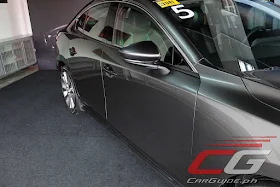August 28, 2019
Torque Vectoring Wipers, Climate Control Connected Doors: Mazda Engineers Went Crazy with the 2020 Mazda3
We said it before and we’ll say it again: the 2020 Mazda3 is a technical marvel; it’s a gift that keeps on giving. We’re one of the first in the ASEAN market to bring Mazda’s all-new compact through its paces on a road trip, but before then, we got to speak to its Program Manager.
Koichiro Yamaguchi served as one of the Mazda3’s engineers before being promoted to its Program Manager. And since he’s a true-blue engineer, he’s full of tech nuggets that may otherwise go unnoticed. While we were walking through the design, he paused for a minute near the wiper area, and explained that the wipers have their own sort-of torque vectoring.
Yes, you read that right. We thought taking about the warning chimes is crazy enough, we now have torque vectoring wipers.
Yamaguchi-san explained that excellent visibility forms the foundation of a safe vehicle. With that, Mazda engineers positioned the wipers way lower than previous models. This enables a larger wipe area, covering almost the entire height of the windshield. Thanks to this placement, the wipers are completely invisible from the driver’s seat. Unfortunately, this arrangement also means that typical wiper motors would cause the wiper blade to hit the A-pillar at the last part of its sweep—something that doesn’t fit in Mazda’s new premium positioning.
Mazda’s solution? A wiper motor that varies the torque depending on the curvature of the windshield. Since torque is least at the last part of the wiper’s motion, it effectively slows down making sure each wipe isn’t overly aggressive, eliminating any chance of the wiper hitting the A-pillar.
Aside from the wipers, Yamaguchi-san says they have come up with a novel way to make sure the doors remain easy to open despite the Mazda3’s increased NVH isolation (done by reducing the number of chassis holes and increasing sound deadening and sealing), and resulting vacuum-like environment. Yamaguchi-san explains that the typical solution would be for a hinge that’s slightly angled upward—similar to what you see in Mercedes-Benzes and BMWs. However, Mazda doesn’t see this as good enough. While this setup makes the doors easy to open, it also causes the doors to close (due to their weight) and hit the occupants if they don’t reach the designed stoppers.
Mazda’s solution? They’ve programmed the climate control to let outside air in for a split-second reducing the cabin’s vacuum-like state. It took a lot of time before Mazda perfected this says Yamaguchi-san, but it’s something that they’re quite proud of.
It’s times like these that Mazda engineers could have easily taken the easy way out, and most buyers won’t notice. However, it seems that time and time again, they’ve come up with elegant solutions to the smallest of issues. The 2020 Mazda3 sure sounds likes like one overengineered piece of work, but it also shows how deep their attention to detail goes.




No comments:
Post a Comment
Feel free to comment or share your views. Comments that are derogatory and/or spam will not be tolerated. We reserve the right to moderate and/or remove comments.